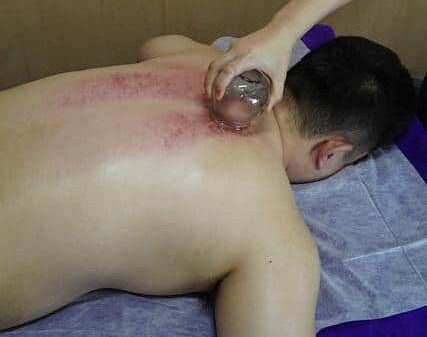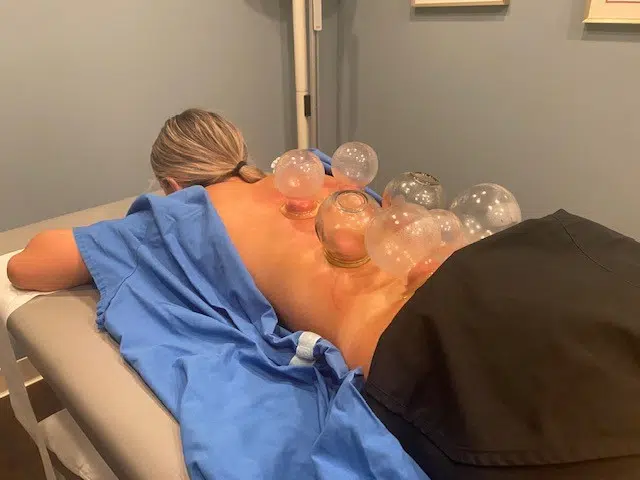Cupping therapy is an ancient form of medicine that has been used for centuries and is still widely practiced in the world today. An integral part of traditional Chinese medicine, cupping therapy is enjoying a resurgence these days. This practice, also commonly called cupping, makes it possible to offer an effective and painless treatment alternative to patients. Whether you’re looking for relief from pain or simply want to relax, cupping therapy may be right for you.

What is Cupping Therapy?
Cupping therapy involves placing vessels called cups on certain places on the patient’s body depending on desired treatment. A vacuum is induced into the cup to draw the patient’s skin and tissue into the cup. Cupping typically creates round temporary, painless bruises on a person’s skin due to tiny blood vessels rupturing after exposure to the suction effects of the procedure. This phenomenon, known as petechiae, is the same thing that happens when someone gets a hickey.
The cups are now typically made of glass, plastic, or silicone, and can be of different sizes. Depending on the specific treatment, cups may be left in place for anywhere from 5 to 15 minutes. This process pulls the skin and underlying tissue up into the cup, which is thought to improve circulation and help relieve pain. Multiple different cultures have used cupping therapy to help with a variety of ailments, from pain relief to detoxification.
A Brief History of Cupping
Cupping therapy is a very old therapy that was practiced in many places around the world and seems to date back to around 3000 BCE. The first recorded use of cupping was in Egypt, but the therapy soon spread to Rome, Greece and other countries of the Mediterranean basin, the Middle East and eventually China and other Eastern cultures.
Cupping was widely practiced and traditionally used to stimulate blood circulation and energy (Chi or Qi) in the body and some practitioners treat using these concepts today. Ancient people used objects that were available and traditional cups were made from bamboo, pottery and even animal horns.
Cupping remained popular throughout the centuries, and by the early 1900s, there were over 200 different types of cupping treatments. However, the practice fell out of favor in the 20th century after the end of the first World War and the advent of antibiotics. It wasn’t until the early 21st century that cupping regained popularity, thanks in part to celebrities like Gwyneth Paltrow and Olympic Swimmers like Michael Phelps.
Today, there are a variety of different cupping treatments available, ranging from traditional fire cupping to modern vacuum cupping. Many practitioners today use plastic cups because of their ease of use and the application of suction using a handheld vacuum pump. They can be cleaned easily but do not slide as easily over the skin as glass cups. Silicone cups are also used today in areas that have an irregular surface, which can be difficult for the other types of cups. All the other types of cups need to presence of fire to create suction.
A flame is briefly introduced into the cup which heats and expands the air in the cup and the cup is placed on the skin. As the air in the cup quickly cools, the air contracts, creates suction and pulls tissue into the cup without heating the cup. This is called fire cupping.
Types of Cupping Therapy
There are a few different options for practicing cupping that depend on the treatment goals of the practitioner using it. The main type of cupping that is practiced is known as static cupping. This is when the cups are applied to the skin and left in place for a period of time, like 5-15 minutes.
The variation to this is called moving cupping, which is where glass cups are moved around while applied with suction to the skin. The sliding occurs easily with the application of oil, lotion or a topical analgesic like Tiger Balm.
Health care providers can also have a person lie still or they can move through some of their range of motion for the joint or muscle.
Another type of option with cupping depends on whether bleeding is induced in the person before applying the cup and suction. Yeah, you read that right. Most cupping uses lotion or oil to help seal the suction but is still known as dry cupping.
Wet cupping refers to when a provider pierces the skin with a lancet beforehand to induce bleeding into the cup. This is typically done in a Traditional Chinese Medicine (TCM) setting to deal with different conditions found in those systems.
At Harmony Chiropractic, we do dry, fire cupping with a myofascial focus using static or moving cupping with or without body movement. We also utilize silicone cups when appropriate for the area, but we do not do wet cupping.

Benefits of Cupping Therapy
Cupping therapy can offer many benefits, including:
- Reducing pain
- Improving circulation
- Relieving anxiety and stress
- Promoting relaxation
- Improving digestion
- Reducing inflammation
- Breaking up scar tissue
- Reducing cellulite
- Easing symptoms of colds and flus.
This process helps to improve blood circulation and loosen tight muscles. It can also be used to relieve pain, reduce inflammation, and some claim that it can encourage detoxification. In recent years, cupping therapy has gained popularity as an alternative treatment for musculoskeletal conditions such as back pain, neck pain, and arthritis. Studies have shown that cupping therapy is effective in reducing pain and improving function in people with these conditions. If you are looking for a non-invasive way to reduce pain and improve your musculoskeletal health, cupping therapy may be worth considering. Please consult your healthcare practitioner to see if this form of therapy is right for you.

Is Cupping Dangerous?
Although cupping therapy is considered safe, it is not suitable for everyone. There can be some side effects like fatigue, headaches, nausea, dizziness, or insomnia. Skin irritation or even ulceration can be a risk as well.
Cupping therapy should be avoided in people with kidney, liver, or heart failure, as well as in people with a pacemaker. It also cannot be used if you have a bleeding disorder such as hemophilia or if you are taking blood-thinning medication. Cupping should not be used on certain pregnant women or young children and it should avoided on any area of the body that is already bruised or injured. While there are some risks associated with cupping therapy such as burns, bruising and skin infections. Cupping is considered safe when performed by a trained and licensed professional, such as chiropractors, acupuncturists, physical therapists and massage therapists.
References
- Al-Bedah AMN, Elsubai IS, Qureshi NA, Aboushanab TS, Ali GIM, El-Olemy AT, et al. The medical perspective of cupping therapy: Effects and mechanisms of action. Journal of Traditional and Complementary Medicine [Internet]. 2019 Apr [cited 2022 Jul 3];9(2):90–7.
- Furhad S;Bokhari AA. Cupping Therapy [Internet]. 2022 [cited 2022 Jul 3].
